A Dynamic Study of a Karst Spring Based on Wavelet Analysis and the Mann-Kendall Trend Test
Abstract
:1. Introduction
2. Materials and Methods
2.1. The Background Conditions of the Study Area
2.2. Data
2.3. Periodic Inspection Method
2.4. Trend Test Method
2.5. Mutation Test Method
3. Results
3.1. General Characteristics of Atmospheric Precipitation and Spring Water Level
3.2. Atmospheric Precipitation and Spring Water Level Cyclical Changes
3.3. Differences between the Trend of Atmospheric Precipitation and Spring Water Level Change
3.4. Atmospheric Rainfall and Detection of Spring Water Level Changes
4. Conclusions
Author Contributions
Acknowledgments
Conflicts of Interest
References
- Guo, L.; Gong, H.L.; Zhu, F.; Guo, X.M.; Zhou, C.F.; Qiu, L. Cyclical characteristics of groundwater level and precipitation based on wavelet analysis. Geogr. Geo-Inf. Sci. 2014, 30, 35–38. [Google Scholar]
- Nakken, M. Wavelet analysis of rainfall–runoff variability isolating climatic from anthropogenic patterns. Environ. Model. Softw. 1999, 14, 283–295. [Google Scholar] [CrossRef]
- Qi, X.; Yang, L.; Han, Y.; Shang, H.; Xing, L. Cross wavelet analysis of groundwater level regimes and precipitation-groundwater level regime in Ji’nan spring region. Adv. Earth Sci. 2012, 27, 969–978. [Google Scholar]
- Tremblay, L.; Larocque, M.; Anctil, F.; Rivard, C. Teleconnections and interannual variability in Canadian groundwater levels. J. Hydrol. 2011, 410, 178–188. [Google Scholar] [CrossRef]
- Xiao-Fan, Q.I.; Jiang, Z.C.; Luo, W.Q. Cross wavelet analysis of relationship between precipitation and spring discharge of a typical epikarst water system. Earth Environ. 2012, 40, 561–567. [Google Scholar]
- Chi, G.Y.; Xing, L.T.; Zhu, H.X.; Hou, X.Y.; Xiang, H.; Xing, X.R. The study of quantitative relationship between the spring water and the dynamic change of the atmospheric precipitation in Ji’nan. Ground Water 2017, 39, 8–11. [Google Scholar]
- Li, X.; Li, G.; Zhang, Y. Identifying major factors affecting groundwater change in the north China plain with grey relational analysis. Water 2014, 6, 1581–1600. [Google Scholar] [CrossRef]
- Chang, F.J.; Chen, P.A.; Liu, C.W.; Liao, H.C.; Liao, C.M. Regional estimation of groundwater arsenic concentrations through systematical dynamic-neural modeling. J. Hydrol. 2013, 499, 265–274. [Google Scholar] [CrossRef]
- Jan, C.D.; Chen, T.H.; Huang, H.M. Analysis of rainfall-induced quick groundwater-level response by using a kernel function. Paddy Water Environ. 2013, 11, 135–144. [Google Scholar] [CrossRef]
- Ke-Zhen, H.U.; Zhang, J.Z.; Xing, L.T. Study on dynamic characteristics of groundwater based on the time series analysis method. Water Sci. Eng. Technol. 2011, 5, 32–34. [Google Scholar]
- Lu, W.X.; Zhao, Y.; Chu, H.B.; Yang, L.L. The analysis of groundwater levels influenced by dual factors in western Jilin province by using time series analysis method. Appl. Water Sci. 2014, 4, 251–260. [Google Scholar] [CrossRef]
- Zhou, T.; Wang, F.; Yang, Z. Comparative analysis of ANN and SVM models combined with wavelet preprocess for groundwater depth prediction. Water 2017, 9, 781. [Google Scholar] [CrossRef]
- Arenas, A.; Schilling, K.; Niemeier, J.; Weber, L. Evaluating the timing and interdependence of hydrologic processes at the watershed scale based on continuously monitored data. Water 2018, 10, 261. [Google Scholar] [CrossRef]
- Huang, L.; Wang, L.; Zhang, Y.; Xing, L.; Hao, Q.; Xiao, Y.; Yang, L.; Zhu, H. Identification of groundwater pollution sources by a SCE-UA algorithm-based simulation/optimization model. Water 2018, 10, 193. [Google Scholar] [CrossRef]
- Faulkner, J.; Hu, B.X.; Kish, S.; Hua, F. Laboratory analog and numerical study of groundwater flow and solute transport in a karst aquifer with conduit and matrix domains. J. Contam. Hydrol. 2009, 110, 34–44. [Google Scholar] [CrossRef] [PubMed]
- Sun, C.; Shu, L.C.; Lu, C.P.; Zhang, C.Y. Physical experiment and numerical simulation of spring flow attenuation process in fissure-conduit media. J. Hydraul. Eng. 2014, 45, 50–57. [Google Scholar]
- Gallegos, J.J. Modeling Groundwater Flow in Karst Aquifers: An Evaluation of Modflow-CFP at the Laboratory and Sub-Regional Scales; Florida State University: Tallahassee, FL, USA, 2011. [Google Scholar]
- Gong, H.L.; Zhao, W.J.; Zhu, Y.Q. Numerical emulation of fissure-karst water and optimization of seepage field. Acta Simul. Syst. Sin. 2002, 14, 186–188. [Google Scholar]
- Shoemaker, W.B.; Kuniansky, E.L.; Birk, S.; Bauer, S.; Swain, E.D. Documentation of a conduit flow process (CFP) for modflow-2005. In Techniques & Methods; U.S. Geological Survey: Reston, VA, USA, 2005; pp. 1–50. [Google Scholar]
- Taweesin, K.; Seeboonruang, U.; Saraphirom, P. The influence of climate variability effects on groundwater time series in the lower central plains of Thailand. Water 2018, 10, 290. [Google Scholar] [CrossRef]
- Dvory, N.Z.; Livshitz, Y.; Kuznetsov, M.; Adar, E.; Yakirevich, A. The effect of hydrogeological conditions on variability and dynamic of groundwater recharge in a carbonate aquifer at local scale. J. Hydrol. 2015, 535, 480–494. [Google Scholar] [CrossRef]
- Thomas, B.F.; Behrangi, A.; Famiglietti, J.S. Precipitation intensity effects on groundwater recharge in the southwestern United States. Water 2016, 8, 90. [Google Scholar] [CrossRef]
- Xiaofan, Q.I.; Wenpeng, L.I.; Chuansheng, L.I.; Yang, L.; Yuhong, M.A. Trends and persistence of groundwater table and precipitation of Ji’nan karst springs watershed. J. Irrig. Drain. 2015, 34, 98–104. [Google Scholar]
- Wu, X.L.; Zhang, B.; Ai, N.S.; Liu, L.J. Wavelet analysis on SO2 pollution index changes of Shanghai in recent 10 years. Environ. Sci. 2009, 30, 2193–2198. [Google Scholar]
- Echer, M.P.S.; Echer, E.; Nordemann, D.J.; Rigozo, N.R.; Prestes, A. Wavelet analysis of a centennial (1895–1994) Southern Brazil Rainfall series (Pelotas, 31°46′19″ S 52°20′ 33″ W). Clim. Chang. 2008, 87, 489–497. [Google Scholar] [CrossRef]
- Jongh, I.L.M.D.; Verhoest, N.E.C.; Troch, F.P.D. Analysis of a 105-year time series of precipitation observed at Uccle, Belgium. Int. J. Climatol. 2006, 26, 2023–2039. [Google Scholar] [CrossRef]
- Kahya, E.; Kalaycı, S. Trend analysis of streamflow in turkey. J. Hydrol. 2004, 289, 128–144. [Google Scholar] [CrossRef]
- Rascher, E.; Sass, O. Evaluating sediment dynamics in tributary trenches in an alpine catchment (Johnsbachtal, Austria) using multi-temporal terrestrial laser scanning. Z. Geomorphol. Suppl. 2017, 61, 27–52. [Google Scholar] [CrossRef]
- Groisman, P.Y.; Knight, R.W.; Karl, T.R. Changes in intense precipitation over the Central United States. J. Hydrometeorol. 2012, 13, 47–66. [Google Scholar] [CrossRef]
- Rajah, K.; O’Leary, T.; Turner, A.; Petrakis, G.; Leonard, M.; Westra, S. Changes to the temporal distribution of daily precipitation. Geophys. Res. Lett. 2015, 41, 8887–8894. [Google Scholar] [CrossRef]
- Fujibe, F. The increasing trend of intense precipitation in Japan based on four-hourly data for a hundred years. Sola 2005, 1, 41–44. [Google Scholar] [CrossRef]
- Kamruzzaman, M. Peer review report 2 on statistical analysis of sub-daily precipitation extremes in singapore. J. Hydrol. Reg. Stud. 2015, 3, 3–4. [Google Scholar] [CrossRef]
- Trenberth, K.E. Changes in precipitation with climate change. Clim. Res. 2011, 47, 123–138. [Google Scholar] [CrossRef]
- Seghieri, J.; Vescovo, A.; Padel, K.; Soubie, R.; Arjounin, M.; Boulain, N.; Rosnay, P.D.; Galle, S.; Gosset, M.; Mouctar, A.H. Relationships between climate, soil moisture and phenology of the woody cover in two sites located along the west African latitudinal gradient. J. Hydrol. 2009, 375, 78–89. [Google Scholar] [CrossRef]
- Belle, G.V.; Hughes, J.P. Nonparametric tests for trend in water quality. Water Resour. Res. 1984, 20, 127–136. [Google Scholar] [CrossRef]
- Hamed, K.H. Exact distribution of the Mann-Kendall trend test statistic for persistent data. J. Hydrol. 2009, 365, 86–94. [Google Scholar] [CrossRef]
- Jiang, X.; Liu, S.; Ma, M.; Zhang, J. A wavelet analysis of the temperature time series in northeast China during the last 100 years. Adv. Clim. Chang. Res. 2008, 27, 122–128. [Google Scholar]
- Sang, Y.F.; Dong, W. Wavelets selection method in hydrologic series wavelet analysis. J. Hydraul. Eng. 2008, 39, 295–300. [Google Scholar]
- Shen, Q.Q.; Shu, J.; Wang, X.H. Multiple time scales analysis of temperature and precipitation variation in shanghai for the recent 136 years. J. Nat. Resour. 2011, 26, 644–654. [Google Scholar]
- Tirogo, J.; Jost, A.; Biaou, A.; Valdes-Lao, D.; Koussoubé, Y.; Ribstein, P. Climate variability and groundwater response: A case study in Burkina Faso (west Africa). Water 2016, 8, 171. [Google Scholar] [CrossRef]
- Chiaudani, A.; Curzio, D.D.; Palmucci, W.; Pasculli, A.; Polemio, M.; Rusi, S. Statistical and fractal approaches on long time-series to surface-water/groundwater relationship assessment: A central Italy alluvial plain case study. Water 2017, 9, 850. [Google Scholar] [CrossRef]
- Liu, Y.L.; Zhai, X.L.; Zheng, A.Q. Analysis of precipitation trend in the Guanzhong basin based on the Mann-Kendall method. Yellow River 2012, 34, 28–30. [Google Scholar]
- Qi, X.F.; Wang, Y.S.; Yang, L.Z.; Liu, Z.Y.; Wang, W.; Wen-Peng, L.I. Time lags variance of groundwater level response to precipitation of Ji’nan karst spring watershed in recent 50 years. Carsol. Sin. 2016, 35, 384–393. [Google Scholar]
- Yu, Y.S.; Chen, X.W. Study on the percentage of trend component in a hydrological time series based on Mann-Kendall method. J. Nat. Resour. 2011, 26, 1585–1591. [Google Scholar]
- Zhang, Q.; Xu, C.Y.; Tao, H.; Jiang, T.; Chen, Y.D. Climate changes and their impacts on water resources in the arid regions: A case study of the Tarim river basin, China. Stoch. Environ. Res. Risk Assess. 2010, 24, 349–358. [Google Scholar] [CrossRef]
- Wang, J.; Jin, M.; Wang, J.; Jin, M. Hydrochemical characteristics and formation causes of karst water in jinan spring catchment. Diqiu Kexue Zhongguo Dizhi Daxue Xuebao/Earth Sci. J. China Univ. Geosci. 2017, 42, 821–831. [Google Scholar]
- Zhang, J.Z.; Yan, L.T. Application of regression analysis in the groundwater dynamic analysis. Ground Water 2010, 32, 88–90. [Google Scholar]
- Labat, D. Cross wavelet analyses of annual continental freshwater discharge and selected climate indices. J. Hydrol. 2010, 385, 269–278. [Google Scholar] [CrossRef]
- Labat, D.; Ababou, R.; Mangin, A. Rainfall-runoff relations for karstic springs. Part II: Continuous wavelet and discrete orthogonal multiresolution analyses. J. Hydrol. 2000, 238, 149–178. [Google Scholar] [CrossRef]
- Labat, D.; Ronchail, J.; Guyot, J.L. Recent advances in wavelet analyses: Part 2—Amazon, Parana, Orinoco and Congo discharges time scale variability. J. Hydrol. 2005, 314, 289–311. [Google Scholar] [CrossRef]
- Mann, H.B. Nonparametric test against trend. Econometrica 1945, 13, 245–259. [Google Scholar] [CrossRef]
- Charlier, J.B.; Ladouche, B.; Maréchal, J.C. Identifying the impact of climate and anthropic pressures on karst aquifers using wavelet analysis. J. Hydrol. 2015, 523, 610–623. [Google Scholar] [CrossRef]
- Zhou, J.; Xing, L.T.; Teng, Z.X.; Wang, L.Y. Study on the Threshold of Main Factors Restricting Ji’nan Large Karst Springs Spewing; East China Normal University: Shanghai, China, 2015; pp. 146–156. [Google Scholar]
- Jukić, D.; Denić-Jukić, V. Investigating relationships between rainfall and karst-spring discharge by higher-order partial correlation functions. J. Hydrol. 2015, 530, 24–36. [Google Scholar] [CrossRef]
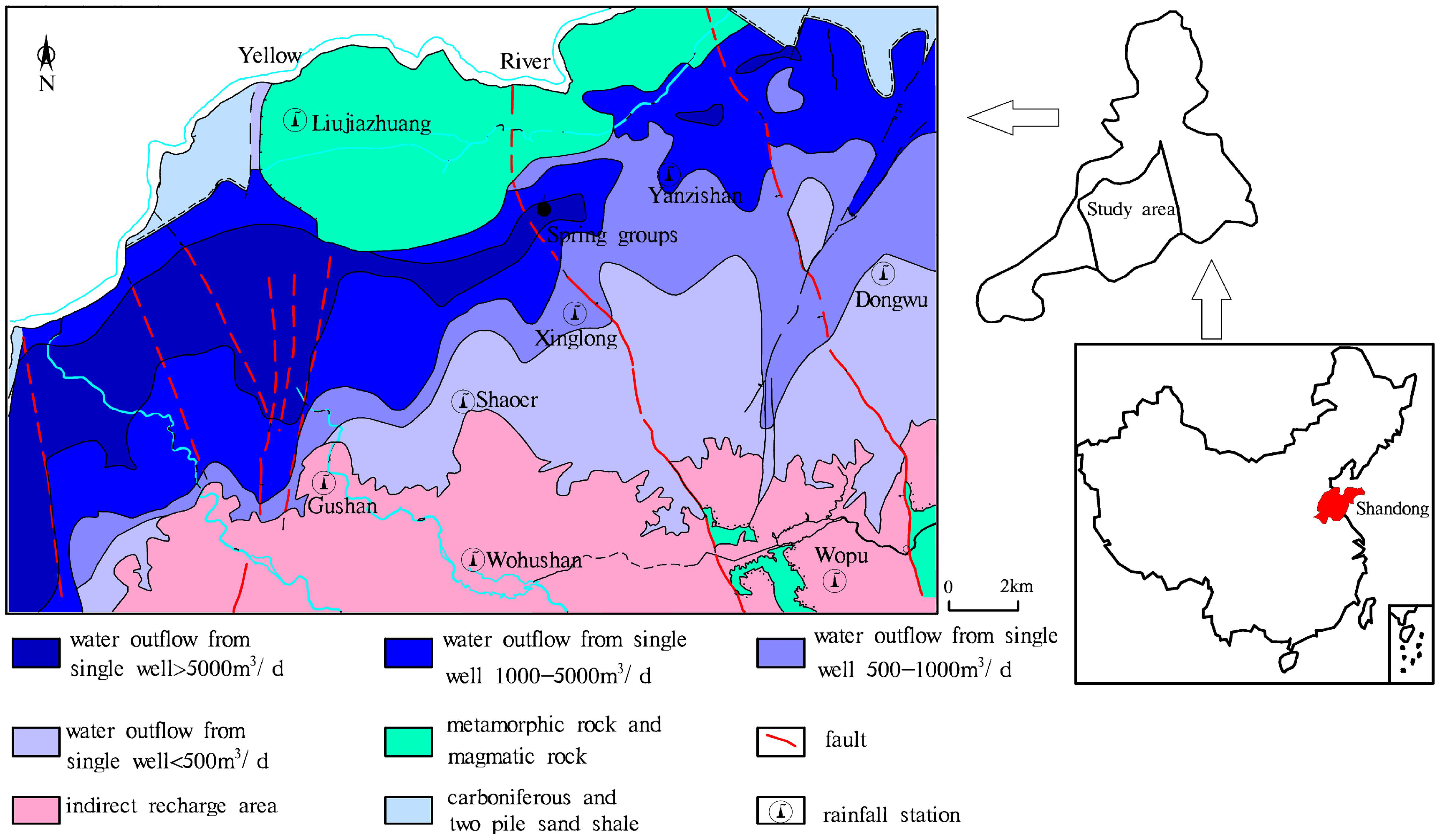

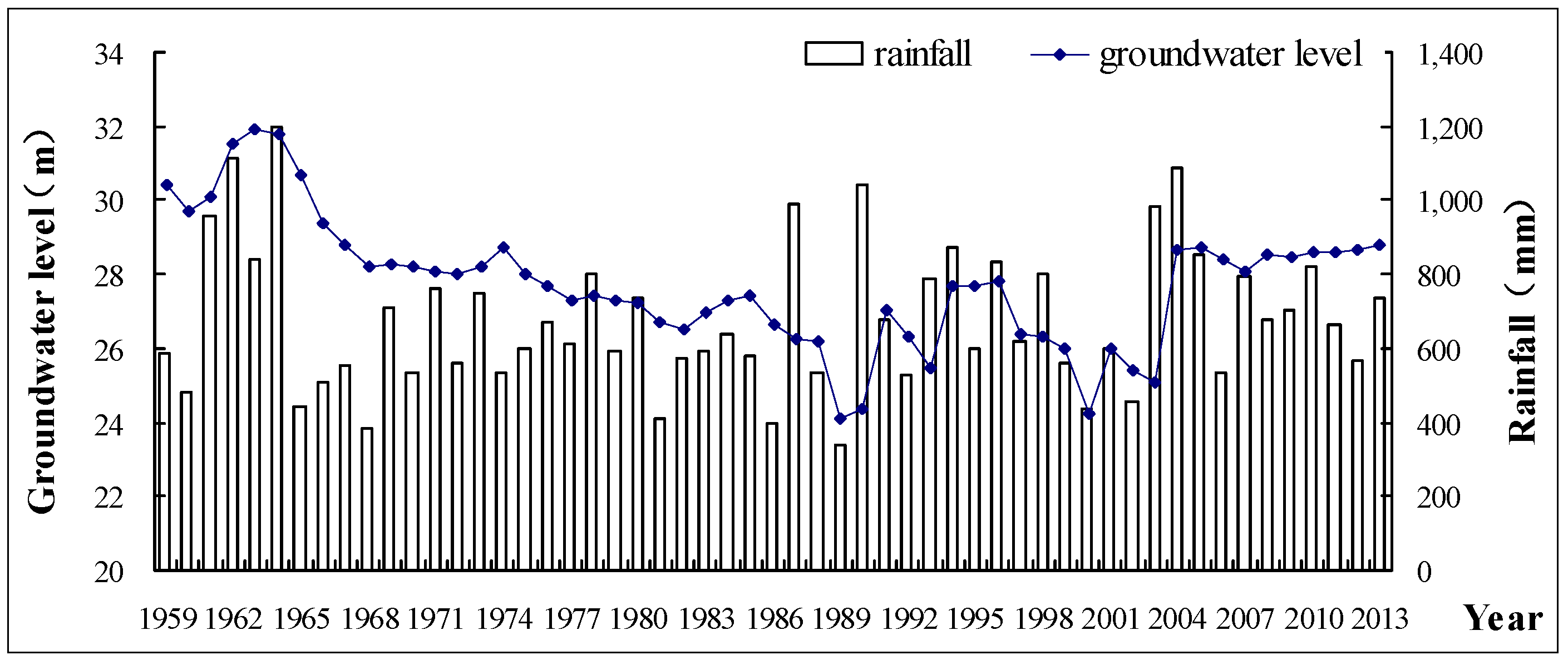

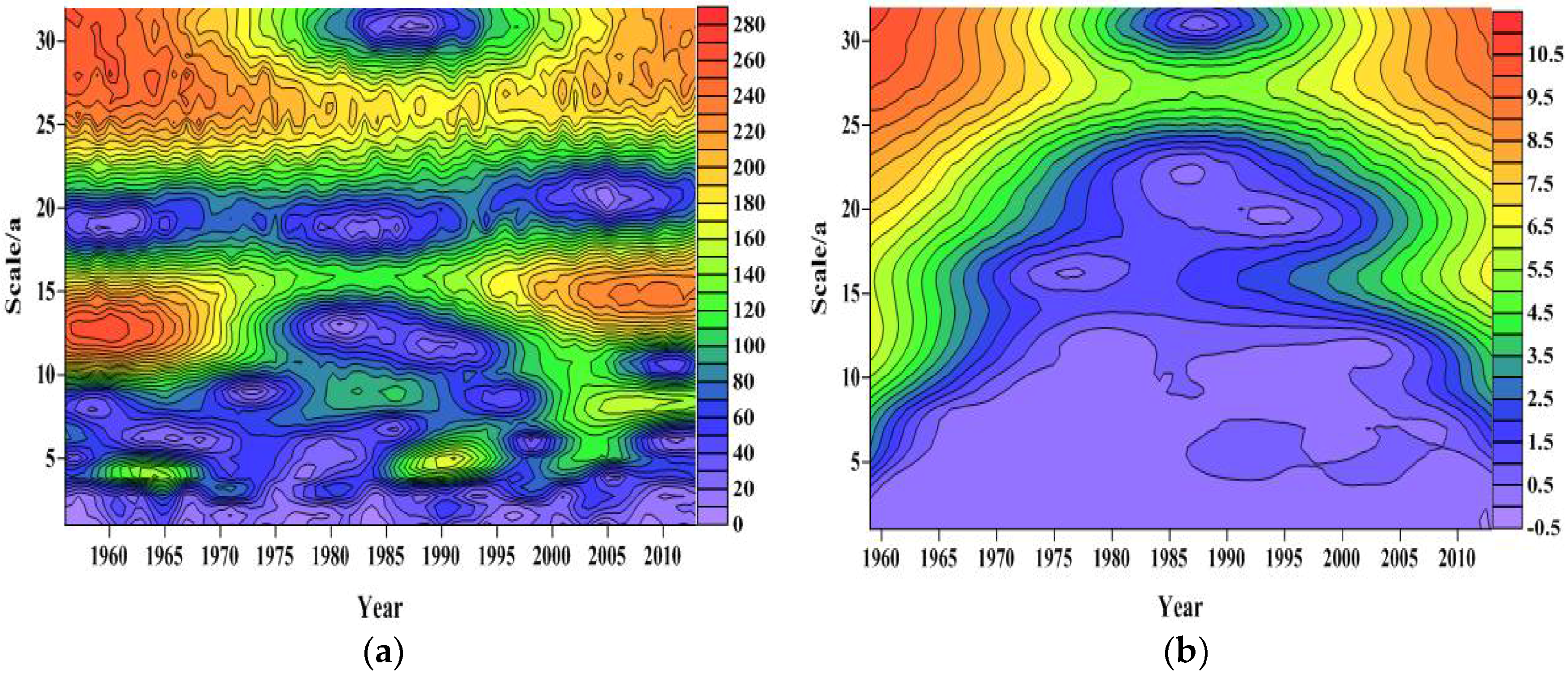
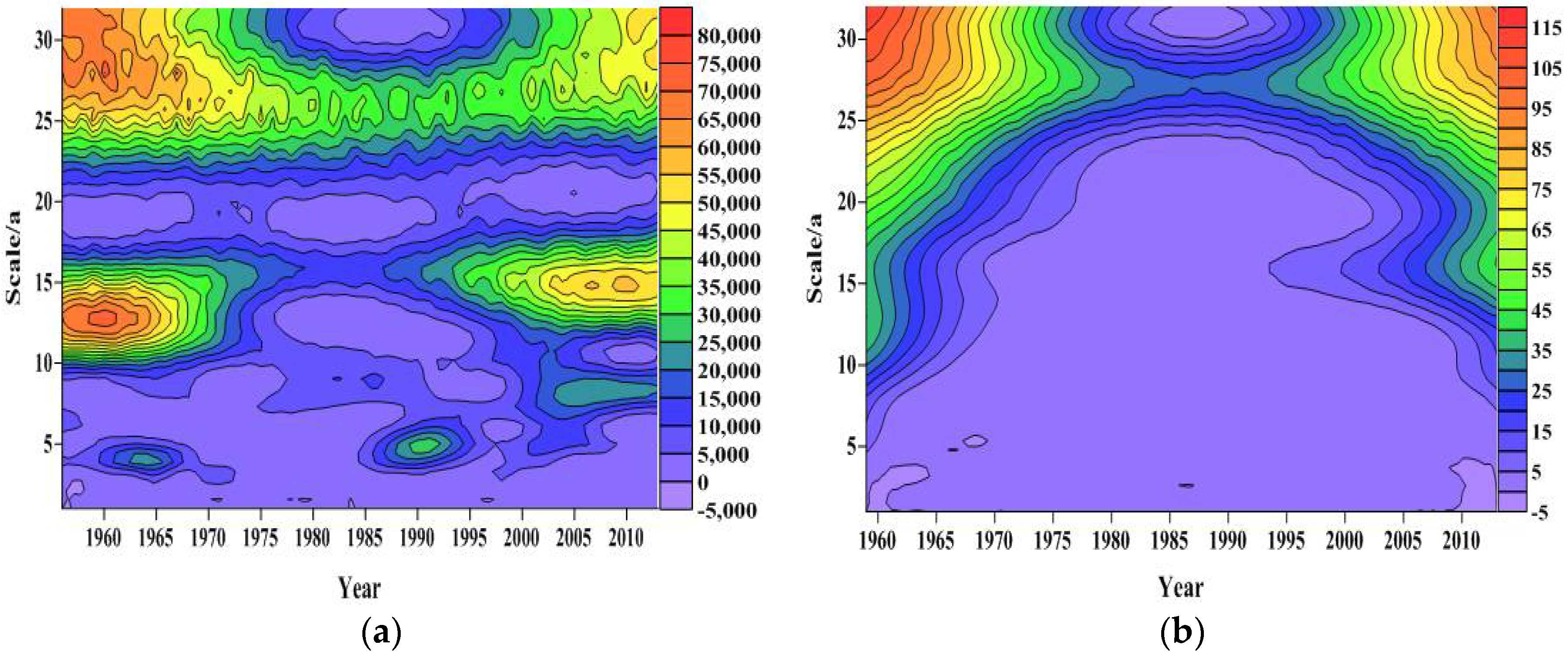

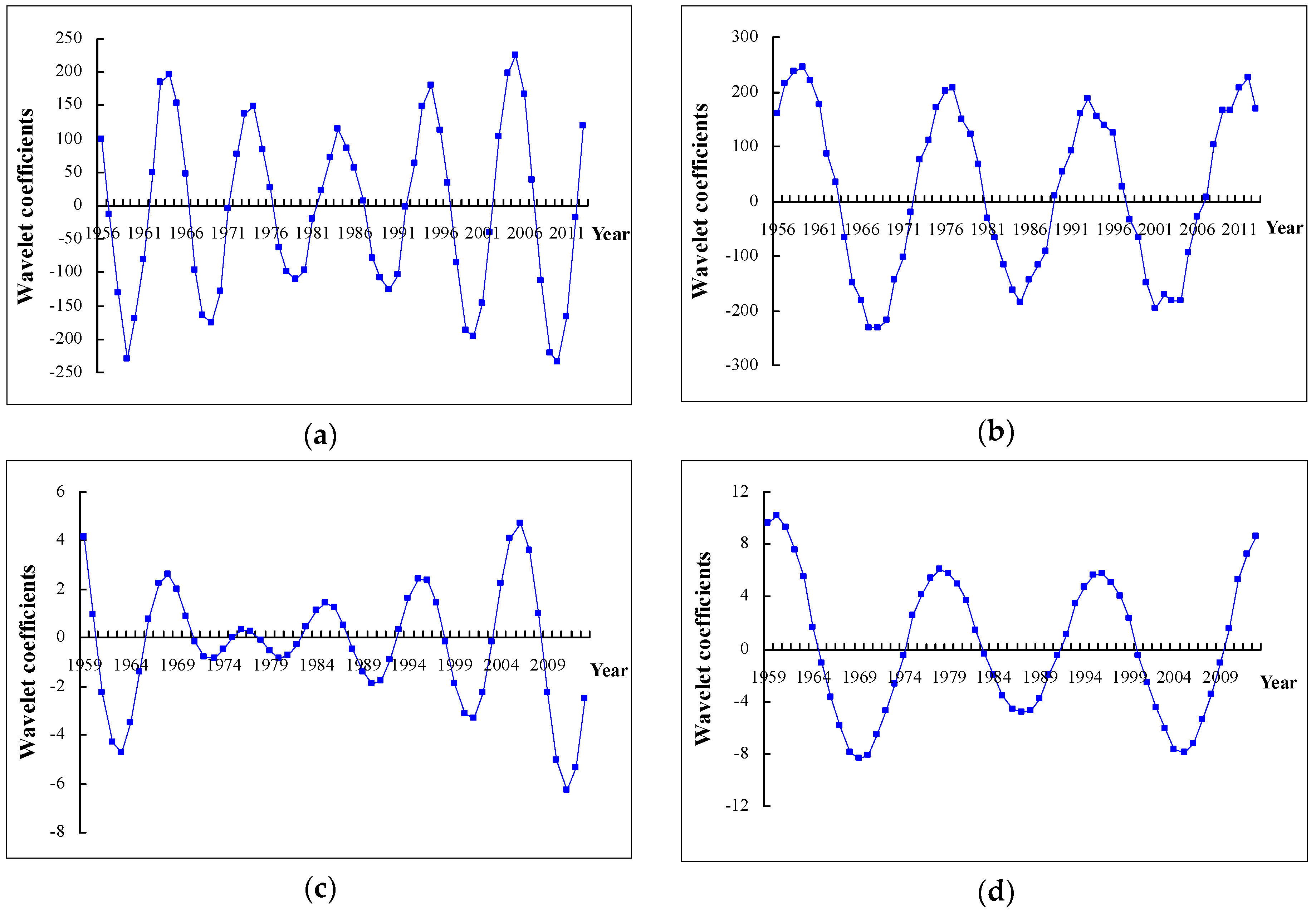
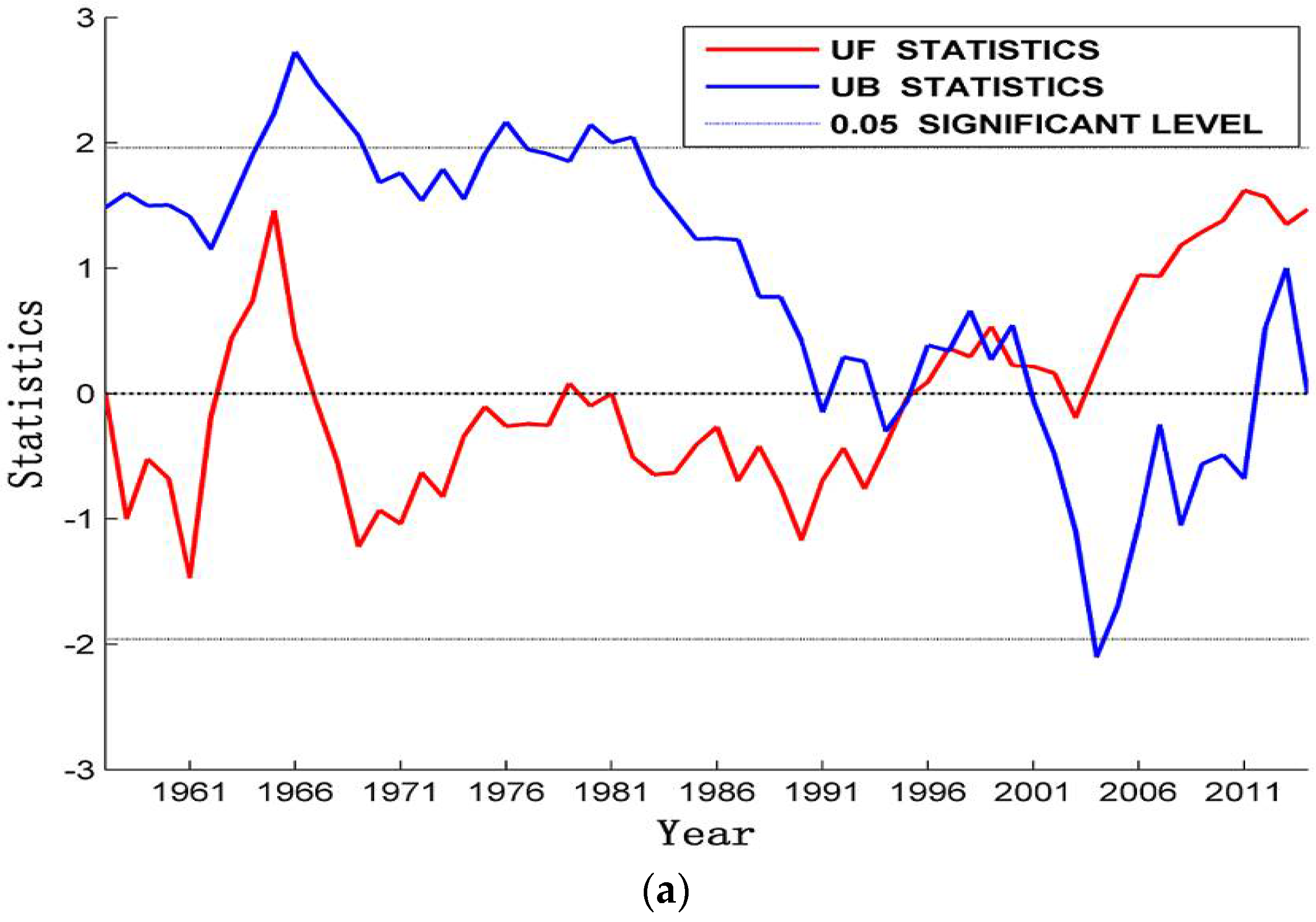
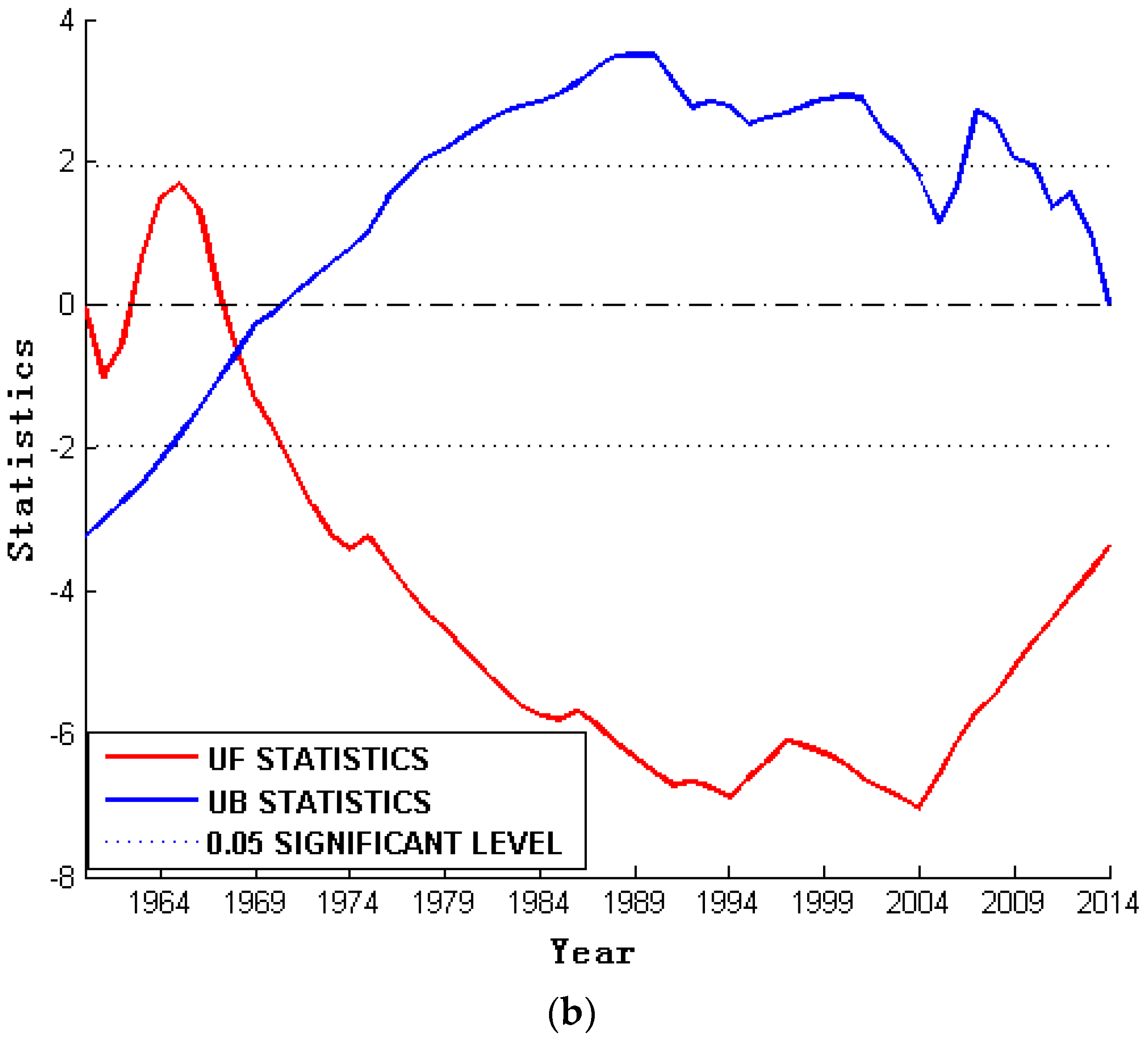
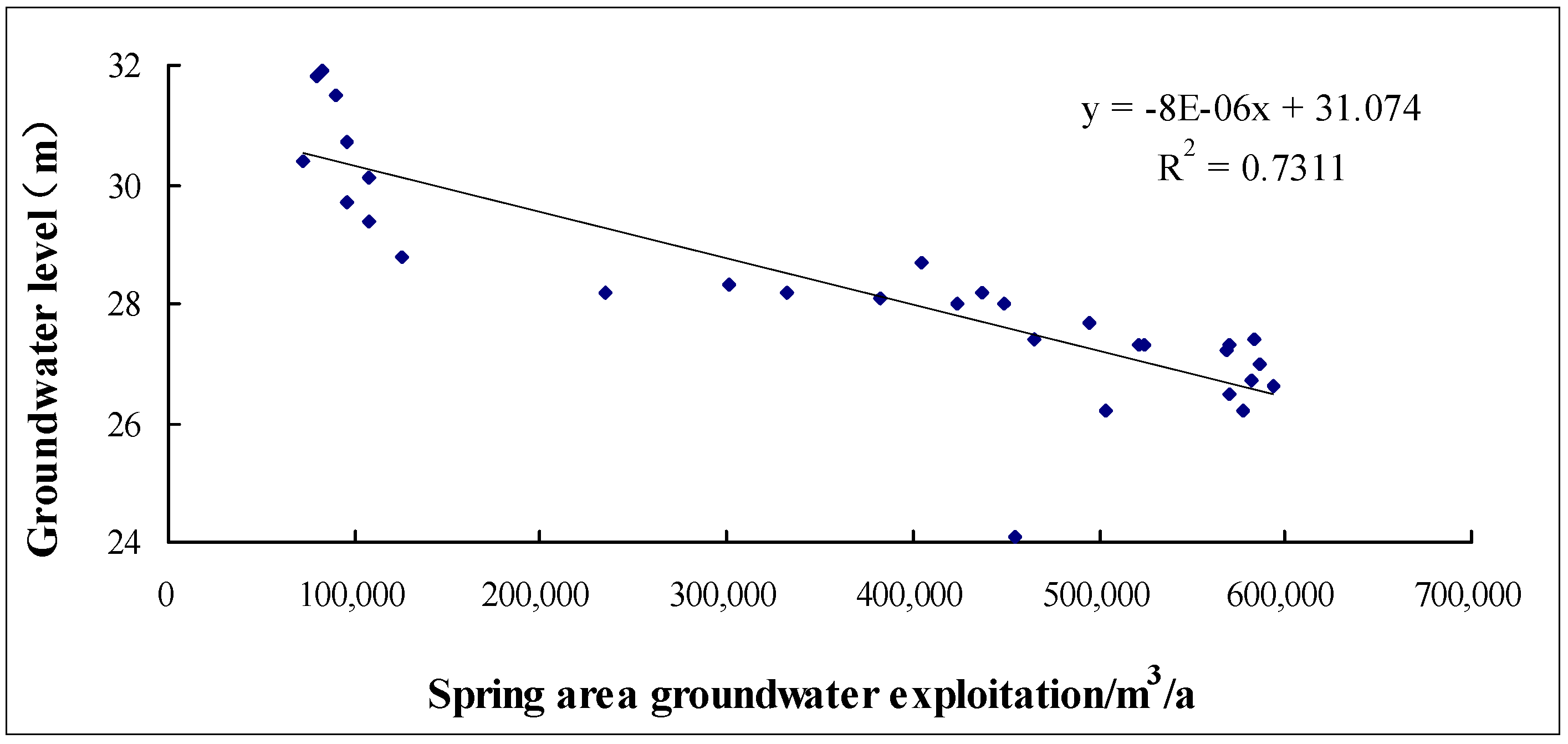
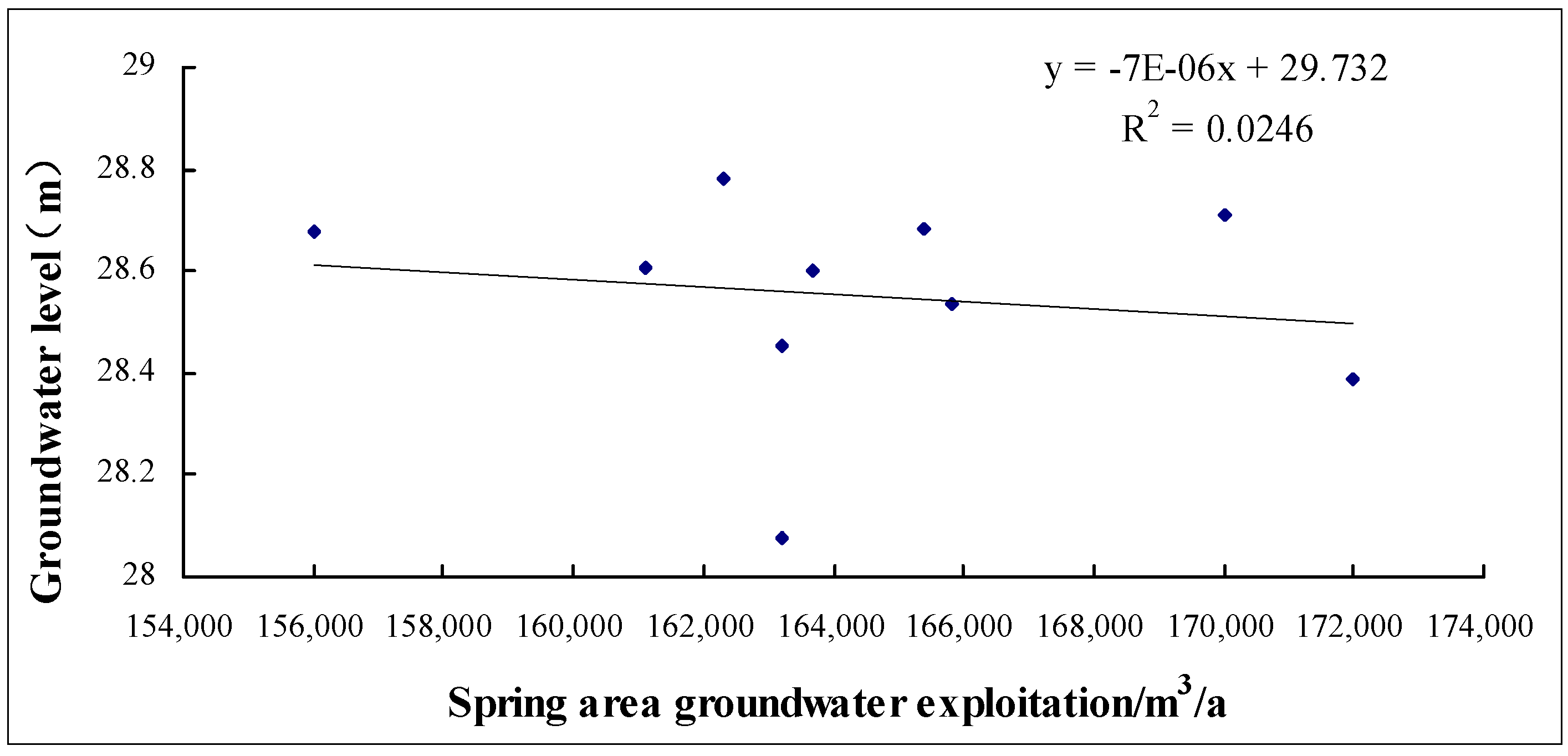
| Project | U | β |
|---|---|---|
| Annual groundwater level | 0.9996 | −0.065 |
| Annual precipitation | 0.2047 | 1.2647 |
| Influencing Factors | Year | |
|---|---|---|
| 1960–1967 | 1968–1989 | |
| Current precipitation and groundwater level | 0.959 | 0.285 |
| Precipitation and groundwater level in the previous year | 0.95 | 0.094 |
| The first two years of precipitation and groundwater level | 0.479 | |
| Urban exploitation and groundwater level | −0.873 | −0.017 |
| Periphery exploitation and groundwater level | −0.572 | |
© 2018 by the authors. Licensee MDPI, Basel, Switzerland. This article is an open access article distributed under the terms and conditions of the Creative Commons Attribution (CC BY) license (http://creativecommons.org/licenses/by/4.0/).
Share and Cite
Xing, L.; Huang, L.; Chi, G.; Yang, L.; Li, C.; Hou, X. A Dynamic Study of a Karst Spring Based on Wavelet Analysis and the Mann-Kendall Trend Test. Water 2018, 10, 698. https://doi.org/10.3390/w10060698
Xing L, Huang L, Chi G, Yang L, Li C, Hou X. A Dynamic Study of a Karst Spring Based on Wavelet Analysis and the Mann-Kendall Trend Test. Water. 2018; 10(6):698. https://doi.org/10.3390/w10060698
Chicago/Turabian StyleXing, Liting, Linxian Huang, Guangyao Chi, Lizhi Yang, Changsuo Li, and Xinyu Hou. 2018. "A Dynamic Study of a Karst Spring Based on Wavelet Analysis and the Mann-Kendall Trend Test" Water 10, no. 6: 698. https://doi.org/10.3390/w10060698




